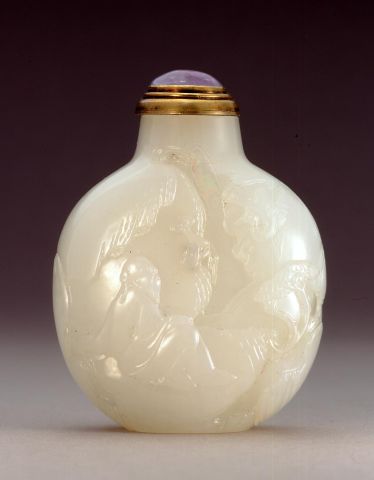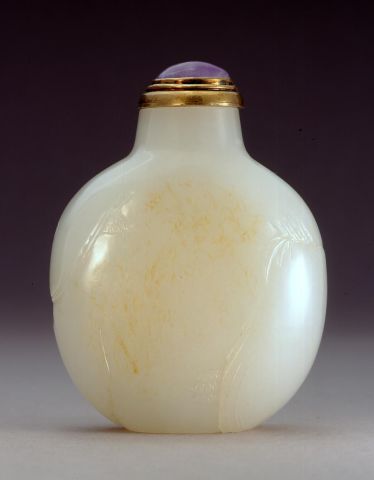

Bottle ID: 112
WHITE, SAGE ON ROCK
Date: 1750-1800
Height: 65 mm
Nephrite, white with a faint russet skin on one side, of rounded form, well hollowed, carved on the front with a sage seated on a rock amidst pine and lingzhi fungus, gazing upwards in contemplation at a crane flying in the mountainous landscape; the reverse uncarved.
Attributed to the Suzhou School.
Similar Examples:
Crane Collection no. 174
Nicollier, Verene. The Baur Collection Geneva, Chinese Snuff Bottles, 2007, pp. 220-221, no. H88.
Stevens, Bob C. The Collector's Book of Snuff Bottles, 1976, pp. 116-117, no. 393.
Sotheby's, London, June 21, 1995, lot 107, The Sone Picking Studio [Cai Shi Xuan].
Sotheby's, New York, September 14, 2010, lot 67, The Joe Grimberg Collection.
Provenance:
Clare Lawrence Ltd.
Exhibited:
Annual Convention ICSBS New York, November 2013
Published:
JICSBS, Autumn 2007, front cover
Amidst the dramatic rockwork and beneath the scrolling clouds are figures; scholars, sages and fishermen - their clothes, hats and other accoutrements highlighted by the carver's skilful use of the stone's natural coloring. Often animals such as monkeys and horses are portrayed, birds of the air and fish of the sea are common subject matters. And whilst mythical figures such as Liu hai and his three legged toad are depicted, dragons tend to be significant by their absence. The reasoning for this is not entirely clear as dragons were an inherent part of Chinese culture except that the urgency to portray the Emperor, symbolically or otherwise, would be lacking on pieces that were not bound for the Palace. One classic characteristic of the 'pictorial' mood of the Suzhou School is the use of the outer russet skin of the jade riverbed pebbles to highlight the design or carving. According to Yang Boda's study of eighteenth century jade wares the use of this is directly attributable to the carvers of Suzhou. There were two diverse reasons for the use of the skin; one aesthetic where the effective use of this material gave a more realistic natural design with the skin used to depict the mountains and woods with the core of the piece usually white, depicting the rivers and waterfalls. The second reason was purely commercial, that during this time jade was valued and sold, even as a finished work of art, by its weight as well as by the quality of the material. In 1785 the Emperor Qianlong wrote:
"Since the price of jade crafts is determined by weight instead of quality and workmanship the carvers all refuse to grind away the flaws".
Using the outer skin as a central design feature fitted these requirements. It is also one of the reasons that flaws in the material were used in the overall design concept rather than discarding that portion. Although this is not documented anywhere it also seems a logical explanation for the lack of hollowing in some bottles of this school where the emphasis is placed on the outer features of the bottle such as the carving.
< Back to full list

 English
English 中文
中文